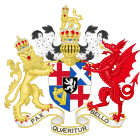Humble Petition and Advice
This articleneeds additional citations forverification.(November 2011) |
 | |
| Introduced by | Sir Christopher Packe |
|---|---|
| Territorial extent | |
| Dates | |
| Commencement | 25 May 1657 |
| Other legislation | |
| Amended by | The removal of the "monarchy" clause |
| Repealed by | |
| Relates to | Instrument of Government |
Status: Revoked | |
TheHumble Petition and Advicewas the second and last codifiedconstitutionof England after theInstrument of Government.
On 23 February 1657, during a sitting of theSecond Protectorate Parliament,SirChristopher Packe,a Member of Parliament and formerLord Mayor of London(chosen by those supporting Kingship as he was a less controversial character than the leaders of the Kingship party), presented theLord ProtectorOliver Cromwellwith a remonstrance which became known as the Humble Petition and Advice.[1]Although he presented it, Packe was not the author.[2][3]
The remonstrance came about largely as a result of the rise of the New Cromwellians, many of whom were moderatePresbyterianslikeEdward Montagu.[4]They in themselves were an expression of strong latent support for monarchy and the English traditional constitutional limits on its power, a desire to lose the military overtones ofthe earlier Protectorateand the decreasing level of control Cromwell was able to exert due to ill health and frustration with a lack of revolutionary ideology amongst his subjects.
The intention of the Humble Petition and Advice was to offer a hereditarymonarchytoOliver Cromwell,to assertParliament's control over newtaxation,to provide an independent council to advise the king, to assure the holding of 'Triennial' meetings (every three years) of Parliament, and to reduce the size of the standing army in order to save money, amongst other things. These had the effect of limiting, not increasing, Cromwell's power. However, the real sticking point for many radicals were Clauses 10 through 12; these placed severe restrictions on sects likeFifth MonarchistsandBaptists,while seeking to re-establish a national church structured along Presbyterian lines.[5]
Cromwell refusedthe Crown,on 8 May 1657. There is much speculation among historians as to why he did so. One popular assertion is that he feared disaffection in the army, especially considering the proposed reduction in its size. Others include that he was distressed by allegations of dynastic ambition, he did not genuinely accept that a monarchy was necessary in England, or that he feared reinstating a monarchy on the basis that he believed the monarchy had been judged by God in the period following theFirst English Civil War.
The Humble Petition and Advice was amended to remove the clause on kingship. TheNaylor casecaused it also to be modified to include asecond chamber.
On 25 May, Cromwell ratified a modified Humble Petition and Advice and said that he would nominate his successor asLord Protector.
References
[edit]- ^Lee,p. 991.(see also DNB xliii 30)
- ^Coward,p. 87
- ^Fritze,p. 237
- ^Davies 2004.
- ^Catterall 1903,pp. 36–37.
Sources
[edit]- Catterall, Ralph C.H. (1903). "The Failure of the Humble Petition and Advice".American Historical Review.9(1): 36–65.doi:10.2307/1834218.JSTOR1834218.
- Coward, Barry,The Cromwellian Protectorate New frontiers in history,Manchester University Press, 2002,ISBN9780719043178
- Davies, JJ (2004). "Montagu [Mountagu], Edward, first earl of Sandwich".Oxford Dictionary of National Biography(online ed.). Oxford University Press.doi:10.1093/ref:odnb/19010.(Subscription orUK public library membershiprequired.)
- Fritze, Ronald H. & Robison, William B.Historical dictionary of Stuart England, 1603–1689,Greenwood Publishing Group, 1996.ISBN978-0-313-28391-8
- Lee, Sidney(1903),Dictionary of National BiographyIndex and Epitome
- Noble, Mark.Memoirs of the protectoral-house of Cromwell: deduced from an early period, and continued down to the present time;... collected chiefly from original papers and records,... together with an appendix:... Embellished with elegant engravings.Volume 1, The third edition, Printed for G. G. J. and J. Robinson, 1787. p. 416.
